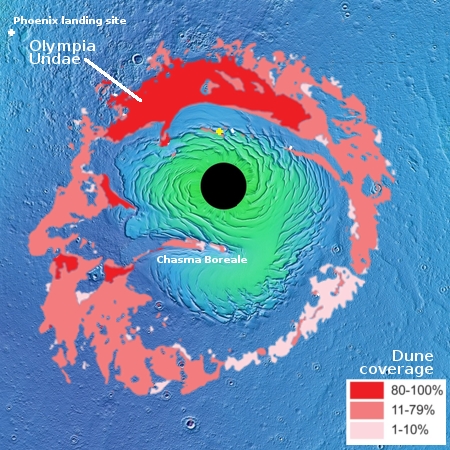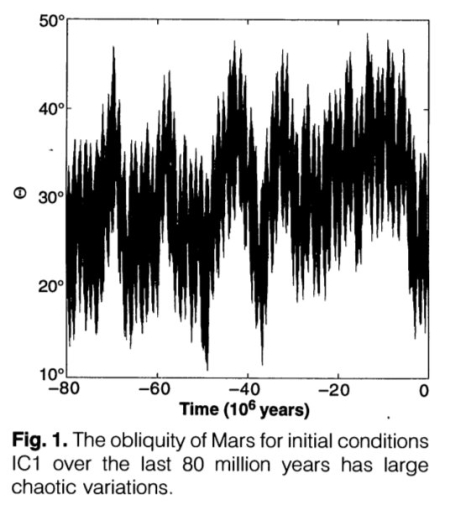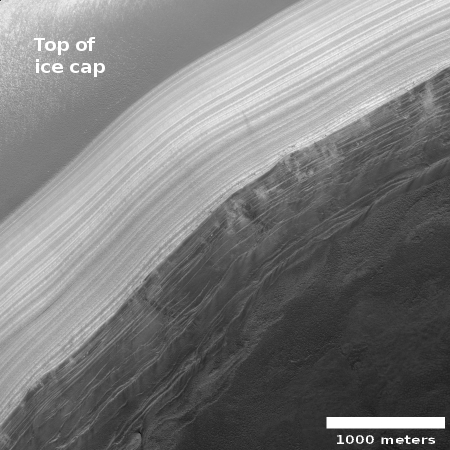The edge of Mars’ north polar ice cap
Cool image time! The photo to the right, cropped and reduced to post here, was taken on December 29, 2019 by the high resolution camera of Mars Reconnaissance Orbiter (MRO) and shows the many-layered scarp face of the Martian north polar ice cap. I have also rotated the image so that north is at the top. The overall height of this scarp is quite high, more than 3,500 feet.
There are a number of very cool features in this image. For example, note what at first look like puffs of clouds just below the contact between the bright and dark layers. I count almost two dozen, with the largest near the center. They are not cloud puffs, however, but areas scoured by past avalanches. According to Patricio Becerra at the University of Bern in Switzerland,
An image from a few years ago shows evidence for the same patches, so they likely happened a while back. When the avalanches or “block falls” occur, they scour the Basal Unit [the dark layer] and break up the exposed surface, causing a brighter/cloudier appearance of the ground than the undisturbed parts.
Avalanches on the scarps of the North Pole icecap occur in great numbers at the beginning of every Martian summer. As sunlight hits the scarp, it causes the carbon dioxide frost layer that settled on the cap during the winter to sublimate away as vapor, and like the freeze-melt cycle on Earth, this sublimation disturbs any unstable ice boulders on the scarp face.
During the early Martian summer, images from MRO routinely capture many such avalanches. Scientists think there could be hundreds to thousands every summer. In many ways, this is similar to the large pieces of ice that routinely calf off the foot of glaciers here on Earth, and that tourists take cruise ships to see in the inside passage of Alaska.
For context, the overview map below indicates with a gold cross where on the icecap’s edge this image is located. The red and pink areas indicate the vast dune fields that surround the icecap.

The number of layers in the scarp is also significant. Each likely represents a cycle in the Martian climate, occurring because of the extreme cyclical changes in the planet’s rotational tilt, its obliquity, over time. When the tilt is as low as 11 degrees, the poles are colder than the mid-latitudes, and water migrates from glaciers in those mid-latitudes to the caps at the poles. When the tilt is as high as 60 degrees, the mid-latitudes are colder than the poles, and that water migrates back from the ice cap to form glaciers in the mid-latitudes.

Right now the obliquity is similar to Earth’s, 25 degrees, so the poles and glaciers are generally in steady-state.
Each time the Martian obliquity goes up — about every million years or so, as shown by the graph to the right (taken from this paper [pdf]), a new layer is laid down at the poles. This scarp face shows them to us.
Finally, the contrast between the bright layers and the dark Basal Unit below, about halfway down, suggests a very fundamental change in the Martian climate occurred about 4.5 million years ago. The upper white layers are thought to be about 95% water ice. The Basal Unit below however is only 60% water, with the rest sand and dust, much of which is thought the source of the vast dune fields that surround the pole.
The graph to the right suggests that change in content was somehow related to a large shift to the planet’s obliquity that occurred at about the same time. Before 4.5 million years ago, Mars’ obliquity ranged from 23 to 45 degrees. Since then the tilt has been far less, ranging from 15 to 35 degrees.
How did this shift cause the new layers on top of the polar cap to suddenly become mostly water? At the moment it appears no one has a compelling explanation, as there is as yet not enough data to formulate a reasonable hypothesis. As Becerra notes,
Although we don’t yet have a full picture of the climate record within the north polar cap, the evidence points to a climatic shift around 4.5 million years ago being responsible for the comparatively large amounts of ice deposited in the north pole since that time, over the already emplaced Basal Unit.
This cyclical process is without doubt fundamental in explaining the geology we find scattered across most of the Martian surface. Getting a better handle on it will not only allow us to better understand the long term evolution of Mars, it will give us better tools for understanding the long term evolution of all planets, all of which will evolve and change in their own unique way.
On Christmas Eve 1968 three Americans became the first humans to visit another world. What they did to celebrate was unexpected and profound, and will be remembered throughout all human history. Genesis: the Story of Apollo 8, Robert Zimmerman's classic history of humanity's first journey to another world, tells that story, and it is now available as both an ebook and an audiobook, both with a foreword by Valerie Anders and a new introduction by Robert Zimmerman.
The print edition can be purchased at Amazon or from any other book seller. If you want an autographed copy the price is $60 for the hardback and $45 for the paperback, plus $8 shipping for each. Go here for purchasing details. The ebook is available everywhere for $5.99 (before discount) at amazon, or direct from my ebook publisher, ebookit. If you buy it from ebookit you don't support the big tech companies and the author gets a bigger cut much sooner.
The audiobook is also available at all these vendors, and is also free with a 30-day trial membership to Audible.
"Not simply about one mission, [Genesis] is also the history of America's quest for the moon... Zimmerman has done a masterful job of tying disparate events together into a solid account of one of America's greatest human triumphs."--San Antonio Express-News
Cool image time! The photo to the right, cropped and reduced to post here, was taken on December 29, 2019 by the high resolution camera of Mars Reconnaissance Orbiter (MRO) and shows the many-layered scarp face of the Martian north polar ice cap. I have also rotated the image so that north is at the top. The overall height of this scarp is quite high, more than 3,500 feet.
There are a number of very cool features in this image. For example, note what at first look like puffs of clouds just below the contact between the bright and dark layers. I count almost two dozen, with the largest near the center. They are not cloud puffs, however, but areas scoured by past avalanches. According to Patricio Becerra at the University of Bern in Switzerland,
An image from a few years ago shows evidence for the same patches, so they likely happened a while back. When the avalanches or “block falls” occur, they scour the Basal Unit [the dark layer] and break up the exposed surface, causing a brighter/cloudier appearance of the ground than the undisturbed parts.
Avalanches on the scarps of the North Pole icecap occur in great numbers at the beginning of every Martian summer. As sunlight hits the scarp, it causes the carbon dioxide frost layer that settled on the cap during the winter to sublimate away as vapor, and like the freeze-melt cycle on Earth, this sublimation disturbs any unstable ice boulders on the scarp face.
During the early Martian summer, images from MRO routinely capture many such avalanches. Scientists think there could be hundreds to thousands every summer. In many ways, this is similar to the large pieces of ice that routinely calf off the foot of glaciers here on Earth, and that tourists take cruise ships to see in the inside passage of Alaska.
For context, the overview map below indicates with a gold cross where on the icecap’s edge this image is located. The red and pink areas indicate the vast dune fields that surround the icecap.

The number of layers in the scarp is also significant. Each likely represents a cycle in the Martian climate, occurring because of the extreme cyclical changes in the planet’s rotational tilt, its obliquity, over time. When the tilt is as low as 11 degrees, the poles are colder than the mid-latitudes, and water migrates from glaciers in those mid-latitudes to the caps at the poles. When the tilt is as high as 60 degrees, the mid-latitudes are colder than the poles, and that water migrates back from the ice cap to form glaciers in the mid-latitudes.

Right now the obliquity is similar to Earth’s, 25 degrees, so the poles and glaciers are generally in steady-state.
Each time the Martian obliquity goes up — about every million years or so, as shown by the graph to the right (taken from this paper [pdf]), a new layer is laid down at the poles. This scarp face shows them to us.
Finally, the contrast between the bright layers and the dark Basal Unit below, about halfway down, suggests a very fundamental change in the Martian climate occurred about 4.5 million years ago. The upper white layers are thought to be about 95% water ice. The Basal Unit below however is only 60% water, with the rest sand and dust, much of which is thought the source of the vast dune fields that surround the pole.
The graph to the right suggests that change in content was somehow related to a large shift to the planet’s obliquity that occurred at about the same time. Before 4.5 million years ago, Mars’ obliquity ranged from 23 to 45 degrees. Since then the tilt has been far less, ranging from 15 to 35 degrees.
How did this shift cause the new layers on top of the polar cap to suddenly become mostly water? At the moment it appears no one has a compelling explanation, as there is as yet not enough data to formulate a reasonable hypothesis. As Becerra notes,
Although we don’t yet have a full picture of the climate record within the north polar cap, the evidence points to a climatic shift around 4.5 million years ago being responsible for the comparatively large amounts of ice deposited in the north pole since that time, over the already emplaced Basal Unit.
This cyclical process is without doubt fundamental in explaining the geology we find scattered across most of the Martian surface. Getting a better handle on it will not only allow us to better understand the long term evolution of Mars, it will give us better tools for understanding the long term evolution of all planets, all of which will evolve and change in their own unique way.
On Christmas Eve 1968 three Americans became the first humans to visit another world. What they did to celebrate was unexpected and profound, and will be remembered throughout all human history. Genesis: the Story of Apollo 8, Robert Zimmerman's classic history of humanity's first journey to another world, tells that story, and it is now available as both an ebook and an audiobook, both with a foreword by Valerie Anders and a new introduction by Robert Zimmerman.
The print edition can be purchased at Amazon or from any other book seller. If you want an autographed copy the price is $60 for the hardback and $45 for the paperback, plus $8 shipping for each. Go here for purchasing details. The ebook is available everywhere for $5.99 (before discount) at amazon, or direct from my ebook publisher, ebookit. If you buy it from ebookit you don't support the big tech companies and the author gets a bigger cut much sooner.
The audiobook is also available at all these vendors, and is also free with a 30-day trial membership to Audible.
"Not simply about one mission, [Genesis] is also the history of America's quest for the moon... Zimmerman has done a masterful job of tying disparate events together into a solid account of one of America's greatest human triumphs."--San Antonio Express-News


